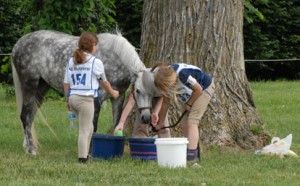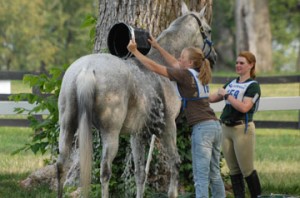In the Vet Box
Today’s post was submitted with information from Dr. Claudia L. Barton, DVM and Dr. Yvette Seger. Dr. Barton and Dr. Seger have had extensive experience running the vet box at USPC rallies. Dr Seger is also a Chief Horse Management Judge. Other information for the report was compiled from articles concerning cooling out the horse and from the USPC Rulebook on Eventing.

Why is the vet box required at an Eventing Rally and not at a recognized — USEA Horse Trial? Pony Club still requires it because we feel you need to learn how your horse recovers from the effort of cross country. Vet box staff take a lot of time to record your horse’s vitals and monitor how quickly your horse recovers from your cross country run.
As you know, you are to go directly from the finish line of your cross country course to the vet box. You are not supposed to stop and talk with your parents or coach, this can be done after the vet has released you from the box. If you do not complete the cross country course, you are asked to go directly from your point on course to the vet box. Please let the vet who greets you know that your mount has been walking due to not completing the course and may already be at resting Temperature, Pulse, and Respiration (TPR) rates.
A lot of people wonder what to do after they check-in with the vet and horse management judge(s) (HMJs)? You and your teammates should start getting your horse cooled down. This is done by putting cold water at arterial points (i.e., where you see veins popping out, like the throat and between the hind legs.) The cold water wicks the heat from your horse’s body, so you need to then scrape the now hot water off (otherwise, it’s like a big wet blanket). It also helps to walk in large circles around the entire vet box area between each round of sponging and scraping water on and off your horse. 
When getting water for your horse to drink and/or sponge them off, it is important to make sure you use the official “dipper” buckets to dip into the common trough, then pour water into your wash or drinking buckets. Speaking of buckets, you should have a separate drinking bucket for each horse, but you can share the wash buckets and sponges/scrapers with all the horses on your team.
Another part of the vet box is getting your stuff up to the box and back. This is where labeling becomes very important. Once all the tack is off, it is important to make sure you keep it all together. In many cases, you will pack your stuff up in big LABELED garbage bags, laundry baskets, or big duffel bags to transport back to the stable area. We can’t tell you how many inquiries we have in the Eventing Show Office looking for missing equipment after cross country. Work with your stable manager to develop a plan for the vet box, and make sure they or another member of your team can help you.
If your horse’s resting TPR are higher than most horses, please let the vet know when you enter the vet box. If your horse is sensitive in a particular area when touched and may kick, please let the staff examining your horse know this. Lastly, if you feel you have not been rechecked in a timely fashion, please approach the vet and/or HMJ to ask to be rechecked.



